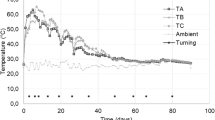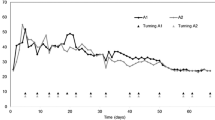Abstract
There is a growing interest in management of MSW through micro-treatment of organic fraction of municipal solid wastes (OFMSW) in many cities of India. The OFMSW fraction is high (>80%) in many pockets within South Indian cities like Bangalore, Chikkamagalur, etc. and is largely represented by vegetable, fruit, packing and garden wastes. Among these, the last three have shown problems for easy decomposition. Fruit wastes are characterized by a large pectin supported fraction that decomposes quickly to organic acids (becomes pulpy) that eventually slow down anaerobic and aerobic decomposition processes. Paper fraction (newsprint and photocopying paper) as well as paddy straw (packing), bagasse (from cane juice stalls) and tree leaf litter (typical garden waste and street sweepings) are found in reasonably large proportions in MSW. These decompose slowly due to poor nutrients or physical state. We have examined the suitability of these substrates for micro-composting in plastic bins by tracking decomposition pattern and physical changes. It was found that fruit wastes decompose rapidly to produce organic acids and large leachate fraction such that it may need to be mixed with leachate absorbing materials (dry wastes) for good composting. Leaf litter, paddy straw and bagasse decompose to the tune of 90, 68 and 60% VS and are suitable for composting micro-treatment. Paper fractions even when augmented with 10% leaf compost failed to show appreciable decomposition in 50 days. All these feedstocks were found to have good biological methane potential (BMP) and showed promise for conversion to biogas under a mixed feed operation. Suitability of this approach was verified by operating a plug-flow type anaerobic digester where only leaf litter gathered nearby (as street sweepings) was used as feedstock. Here only a third of the BMP was realized at this scale (0.18 m3 biogas/kg VS 0.55 m3/kg in BMP). We conclude that anaerobic digestion in plug-flow like digesters appear a more suitable micro-treatment option (2–10 kg VS/day) because in addition to compost it also produces biogas for domestic use nearby.
Similar content being viewed by others
References
Aus-AID (2002). Overview report on environmental sanitation vol 1. Solid waste. Bangalore, India: Australia-India Development Cooperation.
Bari, Q. H., & Koenig, A. (2001). Effect of air recirculation and reuse on composting of organic solid waste. Resources, Conservation and Recycling, 33, 93–111.
Barrington, S., Choiniere, D., Trigui, M., & Knight, W. (2002). Effect of carbon source on compost nitrogen and carbon losses. Bioresource Technology, 83, 189–194.
Barrington, S., Choiniere, D., Trigui, M., & Knight, W. (2003). Compost convective airflow under passive aeration. Bioresource Technology, 86, 259–266.
Centre for Sustainable Technologies (2005). Report on processing facility for Chikkamagalur city, Karnataka. TIDE-CST, Indian Institute of Science, Technical report, July 2005, p5.
Chanakya, H. N., & Jagadish, K. S. (1997). Small-scale biogasification of sorted municipal solid waste. Bioenergy News, 3, 11–15.
Chanakya, H. N., & Moletta, R. (2005). Performance and functioning of USW plug-flow reactors in a 3-zone fermentation model. In B. K. Ahring & H. Hartmann (Eds.), Proceedings of the 4th international symposium on anaerobic digestion of solid wastes. DTU, Copenhagen Aug 31–Sep 02, 2004, vol. 1 (pp. 277–284). International Water Association.
Chanakya, H. N., Ramachandra, T. V., & Vijayachamundeeswari, M. (2006). Anaerobic digestion and reuse of digested products of selected components of urban solid waste. CES Technical report No 114, Centre for Ecological Sciences, Bangalore.
Chanakya, H. N., Srikumar, K. G., Anand, V., Modak, J., & Jagadish, K. S. (1999). Fermentation properties of agro-residues, leaf biomass and urban market garbage in a solid phase biogas fermenter. Biomass and Bioenergy, 16, 417–429.
Daskalopoulos, E., Badr, E., & Probert, S. D. (1997). Economic and environmental evaluations of waste treatment and disposal technologies for municipal solid waste. Applied Energy, 58, 209–255.
de Bertoldi, M., Vallini, G., & Pera, A. (1983). The biology of composting: A review. Waste Management & Research, 1, 157–176.
Fan, H.-j., Shu, H. T., Yang, H. S., & Chen, W. C. (2006). Characteristics of landfill leachates in central Taiwan. Science of the Total Environment, 361, 25–37.
Garcia, A. J., Esteban, M. B., Marquez, M. C., & Ramos, P. (2005). Biodegradable municipal solid waste: Characterization and potential use as animal feedstuffs. Waste Management, 25, 780–787.
Gotaas, H. B. (1956). Composting – Sanitary disposal and reclamation of organic wastes. Geneva: World Health Organization.
Hui, Y., Liao, W., Su, F., & Gang, H. (2006). Urban solid waste management in Chongqing: Challenges and opportunities. Waste Management.
Jagadish, K. S., Chanakya, H. N., Rajabapaiah, P., & Anand, V. (1998). Plug flow digesters for biogas generation from leaf biomass. Biomass and Bioenergy, 14, 415–423.
Karnataka Urban Infrastructure Development Finance Corporation, KUIDFC (2003). Detailed project report for solid waste management in Chikkamagalur city (Report in conjunction with MDPC, DHVC and Communities Group International USA, p. 31).
Lopes, W. S., Leite, V. D., & Prasad, S. (2004). Influence of inoculum on performance of anaerobic reactors for treating municipal solid waste. Bioresource Technology, 94, 261–266.
Rajabapaiah, P. (1988). Energy from Bangalore garbage – A preliminary study. ASTRA Technical Report. Centre for Application of Science and Technology to Rural Areas, Indian Institute of Science, Banagalore 560 012.
Rajabapaiah, P. (1995). Waste management for IISc. ASTRA Technical Report. Centre for Application of Science and Technology to Rural Areas, Indian Institute of Science, Banagalore 560 012.
Ramachandra, T. V. (2006). Management of municipal solid wastes, commonwealth of learning, Canada. New Delhi: Capital Publishing Company.
Sandec (2002). Composting as source of income for the urban poor. SANDEC News, 5, 7–8.
Sathishkumar, R., Chanakya, H. N., & Ramachandra, T. V. (2001). Feasible solid waste management. CES Technical Report No 86, Centre for Ecological Sciences, Bangalore.
Sharma, V. K., Canditelli, M., Fortuna, F., & Cornacchia, G. (1997). Processing of urban and agro-industrial residues by aerobic composting: Review. Energy conservation and management, 38, 457–478.
Slater, R. A., & Frederickson, J. (2001). Composting municipal waste in the UK: Some lessons from Europe. Resources, Conservation and Recycling, 32, 359–374.
TIDE (Technology Informatics Design Endeavour) (2000). Energy recovery from municipal solid wastes in around Bangalore. Technical report. TIDE, Malleshwaram, Bangalore.
TIDE (2003). Municipal solid waste in small towns. Technical report. TIDE, Malleshwarm, Bangalore, 560003.
Yedla, S., & Parikh, J. K. (2002). Development of a purpose built landfill system for the control of methane emissions from municipal solid waste. Waste Management, 22, 501–506.
Zurbrugg, C., Drescher, S., Rytz, I., Sinha, A. H. M. M., & Enayetullah, I. (2005). Decentralised composting in Bangladesh, a win–win situation for all stakeholders, Resources. Conservation and Recycling, 43, 281–292.
Author information
Authors and Affiliations
Corresponding author
Rights and permissions
About this article
Cite this article
Chanakya, H.N., Ramachandra, T.V., Guruprasad, M. et al. Micro-treatment options for components of organic fraction of MSW in residential areas. Environ Monit Assess 135, 129–139 (2007). https://doi.org/10.1007/s10661-007-9711-5
Received:
Revised:
Accepted:
Published:
Issue Date:
DOI: https://doi.org/10.1007/s10661-007-9711-5




